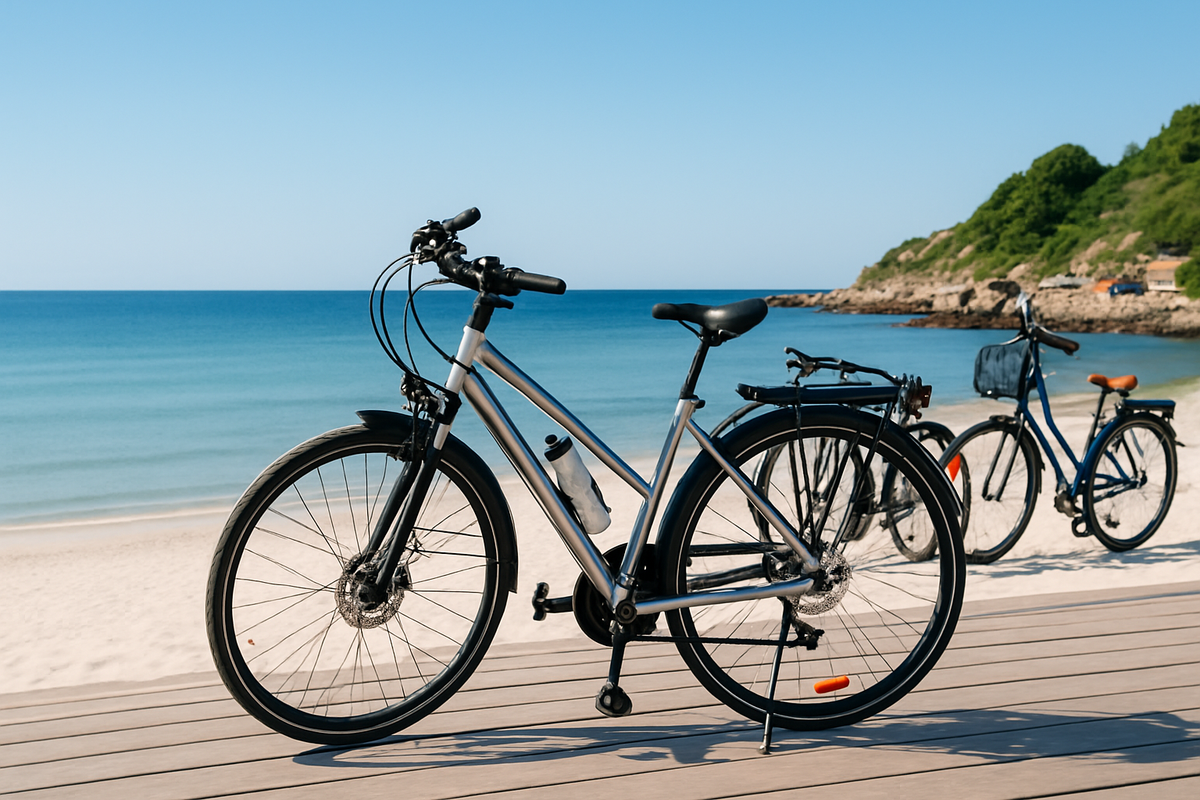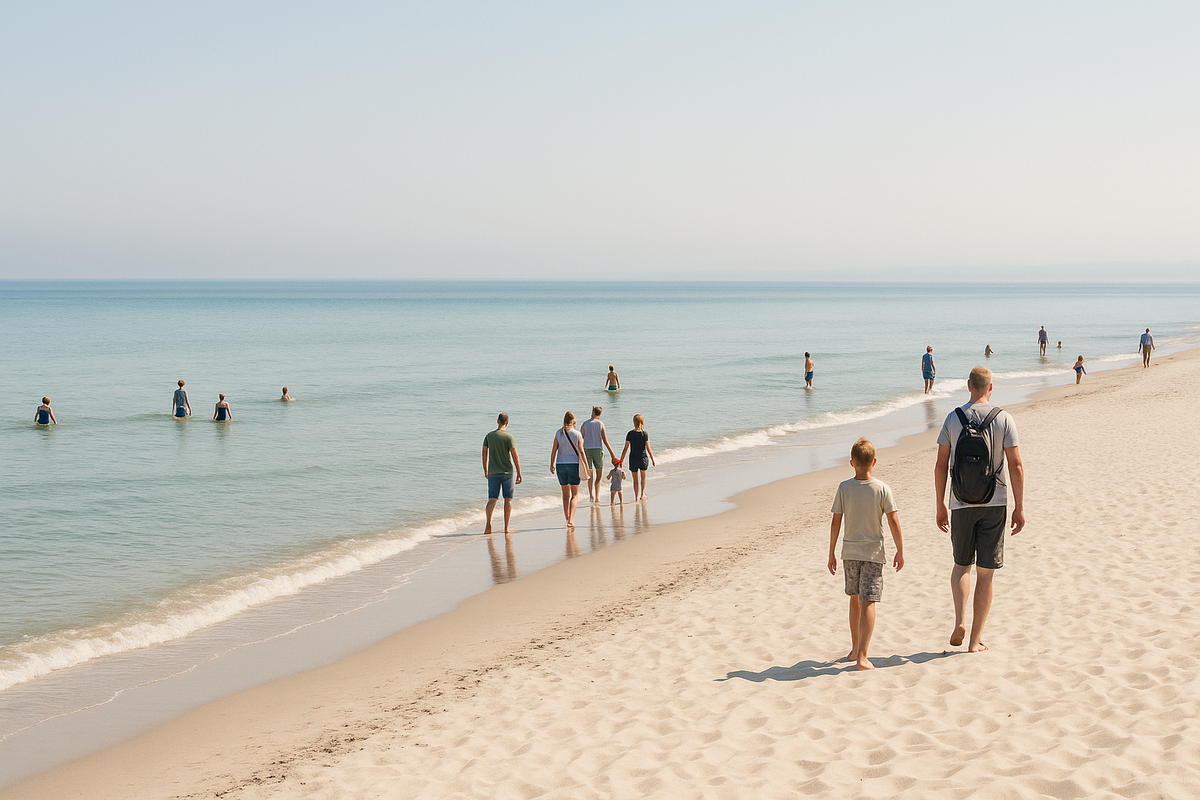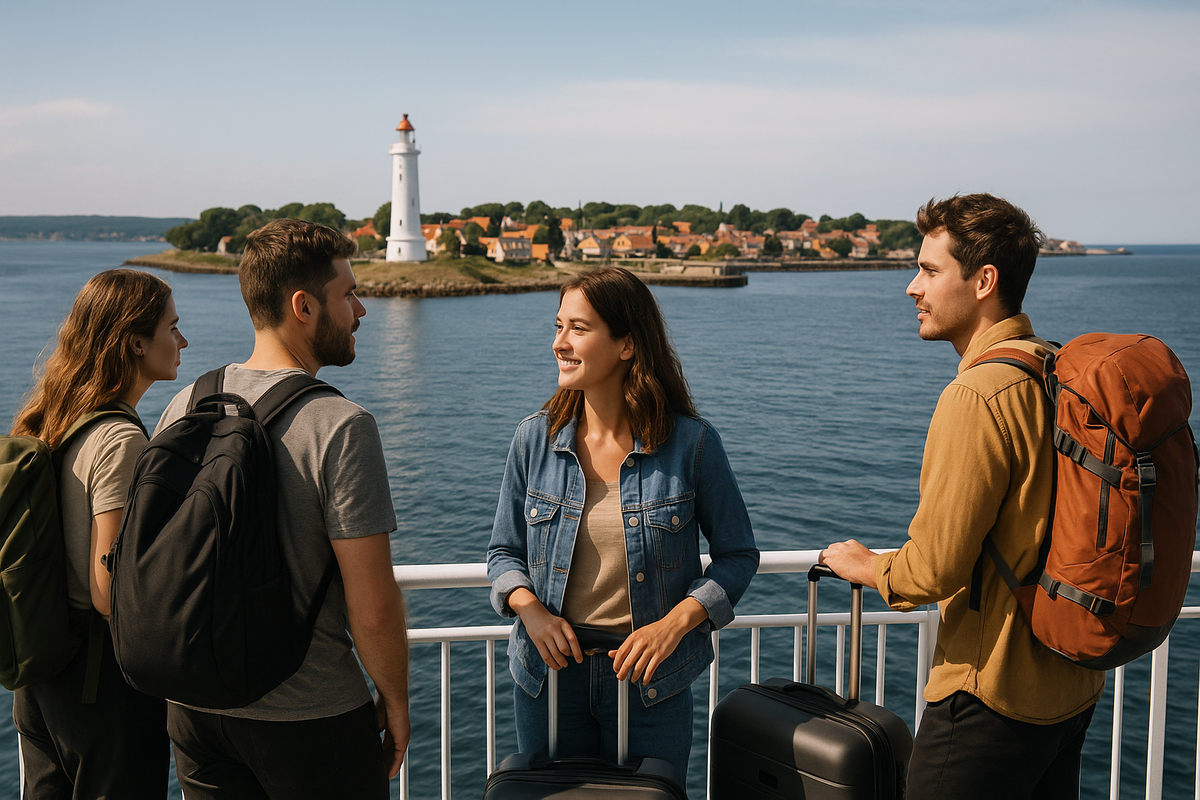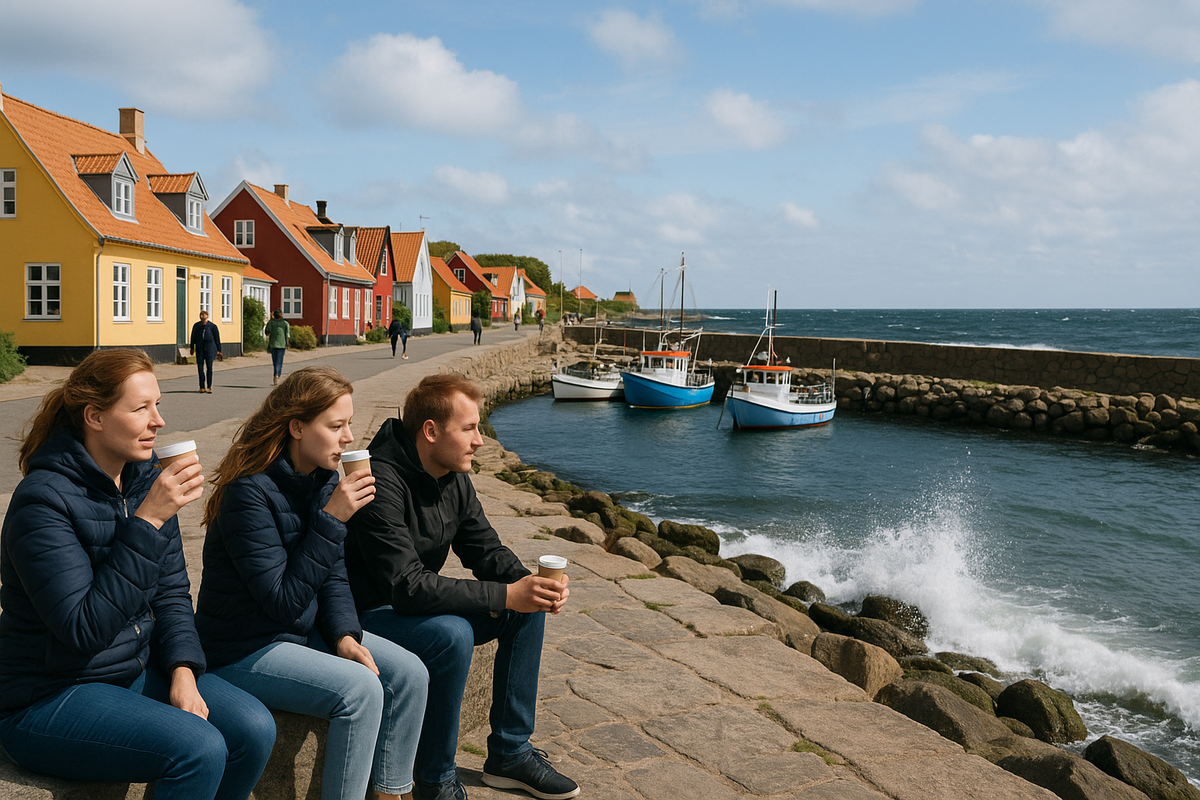🧭 Bornholm for 3–4 days in summer: sun, ferries and a buffer for the weather
Bornholm is not just ‘another beach in Denmark’, but a separate holiday scenario: a compact island with its own rhythm, climate and logistics. In summer, people come here for the sandy beaches, rocky trails, fishing villages and cycle paths with no high-rise buildings on the horizon. But any island means transport risks and limited accommodation options during peak weeks.
Below is a structured analysis of when it is best to go, why 3-4 days are considered the ‘golden mean’ and how to build in a reasonable buffer for weather and ferries.
☀️ The island of sunshine: how Bornholm differs from ‘just the sea in Denmark’

Bornholm is often called ‘sunshine island’: in summer, it objectively has more hours of sunshine and is more often consistently clear than the west coast of Jutland. Add to this the gentle terrain, neat towns, network of cycle routes and developed infrastructure, and you get a ‘sea + active holiday’ format, rather than just lying on the beach.
What makes Bornholm unique:
- 🏖️ The beaches of the south — wide and very light, especially the Dueodde area with its almost white sand.
- 🪨 The cliffs of the north and east — trails along the cliffs, Hammershus fortress, views ‘like mini-Norway’ but without the fjords.
- 🚲 Cycling island — dozens of kilometres of safe cycle paths, including family-friendly ‘car-free’ routes.
- 🐟 Fishing villages — smoked herring, small harbours, craft shops, glassblowing workshops.
Why the basic format is 3–4 days:
- in 3 days you can manage: travel → one ‘beach’ day → one ‘rock/cycling’ day;
- 4 days add a buffer: if one day is blown away by the wind or the ferry is delayed, the programme does not fall apart and the island does not turn into a logistical nightmare.
For families with children, couples or active tourists who like to combine the sea and exercise, 3-4 days is already a holiday, not just a ‘tick in the box’.
🗓️ When to go: high season and quiet periods on the ‘island of the sun’

The logic behind the months on Bornholm is quite transparent: the closer to the middle of summer and school holidays, the warmer the water, the higher the occupancy and prices.
🗺️ Season by month
The approximate ‘season map’ looks like this:
| 📅 Month | 🌤️ Atmosphere & weather | 👥 People & prices | 🎯 Best for |
|---|---|---|---|
| 📆 Late May | Already warm, but the water is still cool | Calm, prices lower | Walks, cycling, not about swimming with kids |
| 📆 June | Long days, everything green, water warming up | Moderate, before peak holidays | Balance: active holiday + first beach days |
| 📆 July – early Aug | Warmest sea, maximum sun | Peak: many people, higher prices | Families who want a “real” summer picture |
| 📆 Late Aug | Still warm, the sea keeps its warmth | Fewer tourists, softer prices | Great post-peak window |
| 📆 September | Mild, can be cooler but still comfortable | Quiet, more hotel availability | Couples, trekking, cycling, gastronomy |
Key conclusions:
- If beaches and swimming are important to you, it is best to look at July to late August, bearing in mind that this is the peak season in terms of crowds and prices.
- If you want peace and quiet and to save money, and swimming is an option rather than a goal, June and the first half of September offer a comfortable balance.
- Even in summer, it's useful to keep in mind that ‘one day may be windy/rainy’ and consider it part of the game, not a force majeure.
⛴️ How to get there: ferries, planes and a buffer for the weather

You can't ‘just take the train’ to Bornholm — it's always ferry or plane, sometimes in combination with a train/car. That's why you need to be more careful about dates and connections here than you would be for a trip from Copenhagen to Aarhus.
⛴️ Ferries
Basic scenario:
- Ystad (Sweden) → Rønne (Bornholm)
- fast ferry approx. 1 hour 15–30 minutes;
- several trips a day in summer;
- to Ystad — about an hour from Copenhagen by train/car.
Alternatives:
- night route Køge (near Copenhagen) → Rønne;
- seasonal flights from Germany (Sassnitz → Rønne).
Risks: strong winds, fog, storms — the ferry may be delayed, rescheduled or cancelled, especially during periods of changing weather.
✈️ Planes
- Short flight Copenhagen (CPH) → Rønne (RNN), about 35–40 minutes in the air.
- In summer, there are usually several flights a day, plus departures from other Danish cities.
Pros: fast, convenient, minimal sea surprises.
Cons: higher price than the ferry + still dependent on weather conditions and slots.
⚖️ Comparative mini-table
| 🚗 Option | ⏱️ Travel time (non-stop) | ✅ Pros | ⚠️ Cons |
|---|---|---|---|
| 🚢 Ferry Ystad–Rønne | ~1.5 h | Car/bike with you, sea atmosphere | Dependent on storms, travel to Ystad |
| ⛴️ Ferry Køge–Rønne | Overnight | Saves daytime hours | Overnight trip, less flexibility |
| ✈️ Flight CPH–RNN | ~40 min | Fast, convenient with children | Price, baggage limits, weather-related delays |
🧩 Why you need a buffer
The golden rule of the island:
Do not schedule your ferry/flight to connect directly with an international flight or an important connection.
In practical terms, this means:
- do not plan your flight home ‘a couple of hours after the ferry’;
- allow at least half a day to a day if you are tied to a long-haul flight;
- keep in mind the scenario: ‘one day may be spent waiting/rearranging tickets’ — and it is better if this is the day before the ferry, not after it.
🚲 Routes for 3 and 4 days: beaches, bicycles, cliffs and ‘plan B’

Below are two basic scenarios. They can be adapted to any base (Rønne, Dueodde, Svaneke, Gudhjem) and to your mode of transport (bicycle, car, bus).
Option A: 3 days — minimal but workable
Day 1 — arrival and getting acquainted
- Morning ferry/flight, check-in at accommodation, lunch.
- First walk around Rønne or your town: harbour, old town, short walk to the sea.
- In the evening — a quiet dinner and checking the forecast/routes for tomorrow.
Day 2 — a big active day
Option 1: south and beaches
- Cycling or driving route to Dueodde and neighbouring beaches.
- Sand, swimming, walks in the dunes, cafés by the sea.
- Return through small villages, farm shops, and viewpoints.
Option 2: north and cliffs
- Trip to Hammershus and the rocky coast.
- Walks along the cliffs, viewpoints, stops in small towns along the way.
Day 3 — flexible and ‘backup’
- If the weather is good — return to your favourite beach or take a short hike before departure.
- If it's stormy — towns, museums, ceramics, glass, smoked fish, inland forest trails.
- During the day/evening — return to the mainland, without the stress of ‘five minutes to the plane’.
Option B: 4 days — comfort with a buffer
Days 1–2 — same as option A (arrival + first active day).
Day 3 — second full itinerary
- East coast: Svaneke, Gudhjem, routes along the cliffs and through villages.
- Stop at a smokehouse for smoked fish, tastings, craft shops, viewing platforms.
Day 4 — buffer day and conclusion
- This day is a ‘safety net’ if one of the previous days was lost due to wind or heavy rain.
- In good weather: return to your favourite beach, an easy day of cycling, a last early lunch by the sea.
- In bad weather: a museum/gastronomic day and a leisurely departure without rushing.
This format is especially comfortable for families and tourists who don't want to turn their holiday into a battle with ferry schedules.
🏡 Where to stay and what to do on a windy day

Your choice of base greatly influences what each day will look like. The logic is simple: where you spend the night is your ‘ground zero’ for all routes.
🏠 Areas for a base
- Rønne
- Pros: ferry, airport, infrastructure, convenient starting point in all directions.
- Cons: less ‘picture-perfect’ landscape than in the eastern towns.
- South (Dueodde and surroundings)
- Pros: direct access to the best sandy beaches, ideal for families with children and lovers of ‘the sea every day’.
- Cons: further to travel to the rocky north and east.
- East (Svaneke, Gudhjem and neighbouring villages)
- Pros: a combination of sea, rocks, gastronomy and crafts; very photogenic coastline.
- Cons: accommodation is snapped up quickly in peak season, prices are higher.
🌬️ Things to do when it's windy and rainy
The good thing about Bornholm is that ‘bad weather’ doesn't mean ‘staying in your room’:
- Museums and history — fortresses, museums, round churches, small local exhibitions.
- Crafts and gastronomy — ceramics, glassblowing workshops, tastings, smoked fish, local beer/cider.
- Short routes into the interior of the island — forest trails and paths where the wind is less strong than on the open coast.
🎒 Mini checklist for summer gear
Even in July and August, it's worth thinking about more than just your swimsuit:
- a light but windproof jacket;
- comfortable trainers/hiking boots for trails and cycling;
- a jumper/fleece for evenings by the sea;
- sunscreen and sunglasses — it is a sunny island, after all;
- a small backpack for snacks, water and a change of clothes.
Why a buffer is not an unnecessary expense, but an investment
An extra day on the island means:
- insurance against delayed/cancelled ferries;
- the opportunity to calmly wait out a storm without panicking that you won't make your flight;
- the right to choose which day to go to the beach and which day to go to the cliffs, rather than having to adapt to a single ‘window’.
For Denmark in general, and Bornholm in particular, the following principle applies:
a little more time and leeway = less stress and more enjoyment of the trip.
And it is in this format — 3–4 days with a reasonable buffer — that Bornholm reveals itself as the ‘island of sunshine’ rather than a logistical quest.
❓FAQ
💬 It is best to plan your trip for late May–June or late August–early September, when the weather is comfortable and there are fewer tourists and prices are lower than during the peak season in July.
💬 It is best to take 3–4 days to have time for the beaches, cliffs and cycle routes, plus a buffer for the weather and ferries.
💬 The Baltic Sea is capricious: ferries and flights can be delayed by wind and storms, so tight connections with international flights are risky.
💬 Rønne is a universal base with a port and airport, but for picture-postcard views and gastronomy, many choose the east (Svaneke, Gudhjem) or the south near the beaches of Dueodde.
💬 In bad weather, you can switch to museums, round churches, ceramics and glassblowing workshops, gastronomic stops and short walks along the island's inland





0 comments
Log in to leave a comment